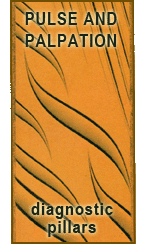Simple Pulse Qualities

These first six pairs of ridiculously simple pulse measurements don’t rely on intuition, self-cultivation, or psychic abilities. They’re all somewhat quantifiable, like the three dimensions of an object: width, depth, length. Add a few more qualities that are reasonably easy to agree on between different practitioners (rhythm, rate, and force) and we’re well on our way to making a decent pulse diagnosis.
I should add also that while writing our book, we wanted these qualities to be different terms from the pulse names. With the exception of “thin”, we were able to achieve this, however different books use many of these terms such as “superficial” while Eastland press (and our book) calls that pulse with the superficial quality “floating”. So that can be a bit confusing. Key point here is that these are the qualities of the pulses, while the names of the pulses that we favor are found in the sidebar on the left of this page.
- Depth: superficial-deep
- Rate: fast-slow
- Rhythm: rhythmic-arrhythmic
- Strength: forceful-forceless
- Width: thin-wide
- Length: short-long
Next is three pairs of slightly less ridiculously simple qualities to add. These are less easy to agree on between practitioners, but only slightly so. These do however require someone to calibrate your fingers such that you can tell the difference between taut tension and the slippery or choppy pulse shape. Don’t try to learn this from words on your computer or a book. You pretty much have to feel them to understand. Again, this isn’t about some metaphysical intuition, but simply a tactile sensation that can’t reliably be transmitted by words alone.
- Tension: taut-slack
- Shape: slippery-choppy
- The Outliers: vibrating-stable
These nine pairs make up the bulk of the qualities you’ll need to know to have a firm and flexible understanding of pulse diagnosis. You’ll notice that the first six are somewhat quantifiable with a high amount of agreement between different individuals feeling the pulse.
The “outliers” only come up on one pulse each. The tight (tense) pulse “vibrates”, and the confined (firm) pulse is “stable”. These two pulses don’t come up too frequently, but I will address them later on.
If you’ve been asking yourself “where’s the beef” in this seminar, it begins on the next page. Enjoy its meaty goodness…
Next: pulse depth.
 Last modified: August 23, 2009
Last modified: August 23, 2009  Tags: Diagnosis, Palpation В· Posted in: Pulse Class, Pulse-Palpation
Tags: Diagnosis, Palpation В· Posted in: Pulse Class, Pulse-Palpation
